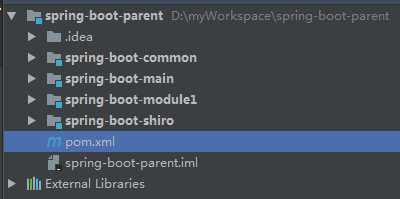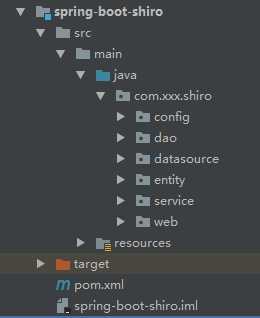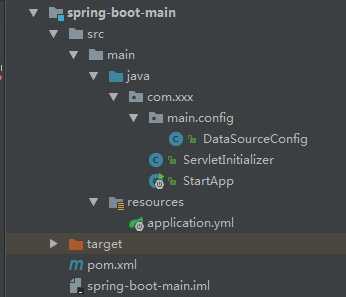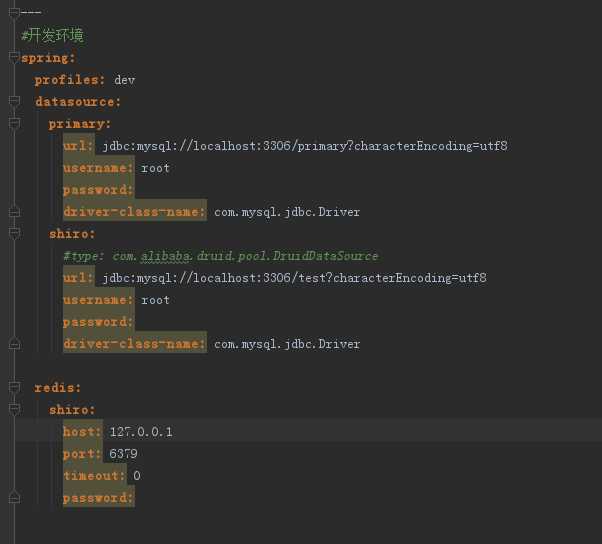标签:except start htm 后台 common 处理 代理 uri 核心
公司在几年前就采用了前后端分离的开发模式,前端所有请求都使用ajax。这样的项目结构在与CAS单点登录等权限管理框架集成时遇到了很多问题,使得权限部分的代码冗长丑陋,CAS的各种重定向也使得用户体验很差,在前端使用vue-router管理页面跳转时,问题更加尖锐。于是我就在寻找一个解决方案,这个方案应该对代码的侵入较少,开发速度快,实现优雅。最近无意中看到springboot与shiro框架集成的文章,在了解了springboot以及shiro的发展状况,并学习了使用方法后,开始在网上搜索前后端分离模式下这两个框架的适应性,在经过测试后发现可行,完全符合个人预期。
本文中项目核心包为SpringBoot1.5.9.RELEASE以及shiro-spring 1.4.0,为了加快开发效率,持久化框架使用hibernate-JPA,为增加可靠性,sessionId的管理使用了shiro-redis开源插件,避免sessionId断电丢失,同时使得多端可共享session,项目结构为多模块项目,详见下图。
其中spring-boot-shiro模块为本文重点,该模块包含shiro核心配置,shiro数据源配置以及各种自定义实现,登录相关服务等。该模块在项目中使用时可直接在pom中引用,并在spring-boot-main入口模块中配置相应数据库连接信息即可,且该模块可以在多个项目中复用,避免重复开发。spring-boot-module1为模拟真实项目中的业务模块,可能会有多个。spring-boot-common中包含通用工具类,常量,异常等等。多模块项目的搭建在本文中不作赘述。
母模块pom.xml代码如下:
<?xml version="1.0" encoding="UTF-8"?> <project xmlns="http://maven.apache.org/POM/4.0.0" xmlns:xsi="http://www.w3.org/2001/XMLSchema-instance" xsi:schemaLocation="http://maven.apache.org/POM/4.0.0 http://maven.apache.org/xsd/maven-4.0.0.xsd"> <modelVersion>4.0.0</modelVersion> <groupId>com.xxx</groupId> <artifactId>spring-boot-parent</artifactId> <packaging>pom</packaging> <version>1.0-SNAPSHOT</version> <modules> <module>spring-boot-main</module> <module>spring-boot-module1</module> <module>spring-boot-shiro</module> <module>spring-boot-common</module> </modules> <properties> <project.build.sourceEncoding>UTF-8</project.build.sourceEncoding> <project.reporting.outputEncoding>UTF-8</project.reporting.outputEncoding> <java.version>1.8</java.version> <spring-boot.version>1.5.9.RELEASE</spring-boot.version> <shiro.version>1.4.0</shiro.version> </properties> <dependencies> <dependency> <groupId>org.springframework.boot</groupId> <artifactId>spring-boot-starter-web</artifactId> <version>${spring-boot.version}</version> </dependency> <!--在外部tomcat中发布故移除内置包--> <dependency> <groupId>org.springframework.boot</groupId> <artifactId>spring-boot-starter-tomcat</artifactId> <version>${spring-boot.version}</version> <scope>provided</scope> </dependency> <dependency> <groupId>org.springframework.boot</groupId> <artifactId>spring-boot-starter-test</artifactId> <version>${spring-boot.version}</version> <scope>test</scope> </dependency> <dependency> <groupId>org.springframework.boot</groupId> <artifactId>spring-boot-devtools</artifactId> <version>${spring-boot.version}</version> <optional>true</optional> </dependency> <dependency> <groupId>org.springframework.boot</groupId> <artifactId>spring-boot-starter-data-jpa</artifactId> <version>${spring-boot.version}</version> </dependency> <dependency> <groupId>org.apache.shiro</groupId> <artifactId>shiro-spring</artifactId> <version>${shiro.version}</version> </dependency> <dependency> <groupId>com.alibaba</groupId> <artifactId>fastjson</artifactId> <version>1.2.8</version> </dependency> <dependency> <groupId>com.alibaba</groupId> <artifactId>druid</artifactId> <version>1.0.28</version> </dependency> <dependency> <groupId>mysql</groupId> <artifactId>mysql-connector-java</artifactId> <version>5.1.39</version> <scope>runtime</scope> </dependency> <!--<dependency>--> <!--<groupId>org.springframework.boot</groupId>--> <!--<artifactId>spring-boot-starter-thymeleaf</artifactId>--> <!--<version>${spring-boot.version}</version>--> <!--</dependency>--> <!--<dependency>--> <!--<groupId>net.sourceforge.nekohtml</groupId>--> <!--<artifactId>nekohtml</artifactId>--> <!--<version>1.9.22</version>--> <!--</dependency>--> </dependencies> </project>
spring-boot-shiro模块接口如下图

传统结构项目中,shiro从cookie中读取sessionId以此来维持会话,在前后端分离的项目中(也可在移动APP项目使用),我们选择在ajax的请求头中传递sessionId,因此需要重写shiro获取sessionId的方式。自定义MySessionManager类继承DefaultWebSessionManager类,重写getSessionId方法,代码如下
import org.apache.shiro.web.servlet.ShiroHttpServletRequest; import org.apache.shiro.web.session.mgt.DefaultWebSessionManager; import org.apache.shiro.web.util.WebUtils; import org.springframework.util.StringUtils; import javax.servlet.ServletRequest; import javax.servlet.ServletResponse; import java.io.Serializable; /** * Created by Administrator on 2017/12/11. * 自定义sessionId获取 */ public class MySessionManager extends DefaultWebSessionManager { private static final String AUTHORIZATION = "Authorization"; private static final String REFERENCED_SESSION_ID_SOURCE = "Stateless request"; public MySessionManager() { super(); } @Override protected Serializable getSessionId(ServletRequest request, ServletResponse response) { String id = WebUtils.toHttp(request).getHeader(AUTHORIZATION); //如果请求头中有 Authorization 则其值为sessionId if (!StringUtils.isEmpty(id)) { request.setAttribute(ShiroHttpServletRequest.REFERENCED_SESSION_ID_SOURCE, REFERENCED_SESSION_ID_SOURCE); request.setAttribute(ShiroHttpServletRequest.REFERENCED_SESSION_ID, id); request.setAttribute(ShiroHttpServletRequest.REFERENCED_SESSION_ID_IS_VALID, Boolean.TRUE); return id; } else { //否则按默认规则从cookie取sessionId return super.getSessionId(request, response); } } }
如何配置让shiro执行我们的自定义sessionManager呢?下面看ShiroConfig类。
package com.xxx.shiro.config; import org.apache.shiro.authc.credential.HashedCredentialsMatcher; import org.apache.shiro.mgt.SecurityManager; import org.apache.shiro.session.mgt.SessionManager; import org.apache.shiro.spring.security.interceptor.AuthorizationAttributeSourceAdvisor; import org.apache.shiro.spring.web.ShiroFilterFactoryBean; import org.apache.shiro.web.mgt.DefaultWebSecurityManager; import org.crazycake.shiro.RedisCacheManager; import org.crazycake.shiro.RedisManager; import org.crazycake.shiro.RedisSessionDAO; import org.springframework.beans.factory.annotation.Value; import org.springframework.context.annotation.Bean; import org.springframework.context.annotation.Configuration; import org.springframework.web.servlet.HandlerExceptionResolver; import java.util.LinkedHashMap; import java.util.Map; /** * Created by Administrator on 2017/12/11. */ @Configuration public class ShiroConfig { @Value("${spring.redis.shiro.host}") private String host; @Value("${spring.redis.shiro.port}") private int port; @Value("${spring.redis.shiro.timeout}") private int timeout; @Value("${spring.redis.shiro.password}") private String password; @Bean public ShiroFilterFactoryBean shirFilter(SecurityManager securityManager) { System.out.println("ShiroConfiguration.shirFilter()"); ShiroFilterFactoryBean shiroFilterFactoryBean = new ShiroFilterFactoryBean(); shiroFilterFactoryBean.setSecurityManager(securityManager); Map<String, String> filterChainDefinitionMap = new LinkedHashMap<String, String>(); //注意过滤器配置顺序 不能颠倒 //配置退出 过滤器,其中的具体的退出代码Shiro已经替我们实现了,登出后跳转配置的loginUrl filterChainDefinitionMap.put("/logout", "logout"); // 配置不会被拦截的链接 顺序判断 filterChainDefinitionMap.put("/static/**", "anon"); filterChainDefinitionMap.put("/ajaxLogin", "anon"); filterChainDefinitionMap.put("/login", "anon"); filterChainDefinitionMap.put("/**", "authc"); //配置shiro默认登录界面地址,前后端分离中登录界面跳转应由前端路由控制,后台仅返回json数据 shiroFilterFactoryBean.setLoginUrl("/unauth"); // 登录成功后要跳转的链接 // shiroFilterFactoryBean.setSuccessUrl("/index"); //未授权界面; // shiroFilterFactoryBean.setUnauthorizedUrl("/403"); shiroFilterFactoryBean.setFilterChainDefinitionMap(filterChainDefinitionMap); return shiroFilterFactoryBean; } /** * 凭证匹配器 * (由于我们的密码校验交给Shiro的SimpleAuthenticationInfo进行处理了 * ) * * @return */ @Bean public HashedCredentialsMatcher hashedCredentialsMatcher() { HashedCredentialsMatcher hashedCredentialsMatcher = new HashedCredentialsMatcher(); hashedCredentialsMatcher.setHashAlgorithmName("md5");//散列算法:这里使用MD5算法; hashedCredentialsMatcher.setHashIterations(2);//散列的次数,比如散列两次,相当于 md5(md5("")); return hashedCredentialsMatcher; } @Bean public MyShiroRealm myShiroRealm() { MyShiroRealm myShiroRealm = new MyShiroRealm(); myShiroRealm.setCredentialsMatcher(hashedCredentialsMatcher()); return myShiroRealm; } @Bean public SecurityManager securityManager() { DefaultWebSecurityManager securityManager = new DefaultWebSecurityManager(); securityManager.setRealm(myShiroRealm()); // 自定义session管理 使用redis securityManager.setSessionManager(sessionManager()); // 自定义缓存实现 使用redis securityManager.setCacheManager(cacheManager()); return securityManager; } //自定义sessionManager @Bean public SessionManager sessionManager() { MySessionManager mySessionManager = new MySessionManager(); mySessionManager.setSessionDAO(redisSessionDAO()); return mySessionManager; } /** * 配置shiro redisManager * <p> * 使用的是shiro-redis开源插件 * * @return */ public RedisManager redisManager() { RedisManager redisManager = new RedisManager(); redisManager.setHost(host); redisManager.setPort(port); redisManager.setExpire(1800);// 配置缓存过期时间 redisManager.setTimeout(timeout); redisManager.setPassword(password); return redisManager; } /** * cacheManager 缓存 redis实现 * <p> * 使用的是shiro-redis开源插件 * * @return */ @Bean public RedisCacheManager cacheManager() { RedisCacheManager redisCacheManager = new RedisCacheManager(); redisCacheManager.setRedisManager(redisManager()); return redisCacheManager; } /** * RedisSessionDAO shiro sessionDao层的实现 通过redis * <p> * 使用的是shiro-redis开源插件 */ @Bean public RedisSessionDAO redisSessionDAO() { RedisSessionDAO redisSessionDAO = new RedisSessionDAO(); redisSessionDAO.setRedisManager(redisManager()); return redisSessionDAO; } /** * 开启shiro aop注解支持. * 使用代理方式;所以需要开启代码支持; * * @param securityManager * @return */ @Bean public AuthorizationAttributeSourceAdvisor authorizationAttributeSourceAdvisor(SecurityManager securityManager) { AuthorizationAttributeSourceAdvisor authorizationAttributeSourceAdvisor = new AuthorizationAttributeSourceAdvisor(); authorizationAttributeSourceAdvisor.setSecurityManager(securityManager); return authorizationAttributeSourceAdvisor; } /** * 注册全局异常处理 * @return */ @Bean(name = "exceptionHandler") public HandlerExceptionResolver handlerExceptionResolver() { return new MyExceptionHandler(); } }
在定义的SessionManager的Bean中返回我们的MySessionManager,然后在SecurityManager的Bean中调用setSessionManager(SessionManager sessionManager)方法加载我们的自定义SessionManager。
MyShiroRealm的代码:
package com.xxx.shiro.config; import com.xxx.shiro.entity.SysPermission; import com.xxx.shiro.entity.SysRole; import com.xxx.shiro.entity.UserInfo; import com.xxx.shiro.service.UserInfoService; import org.apache.shiro.authc.*; import org.apache.shiro.authz.AuthorizationInfo; import org.apache.shiro.authz.SimpleAuthorizationInfo; import org.apache.shiro.realm.AuthorizingRealm; import org.apache.shiro.subject.PrincipalCollection; import org.apache.shiro.util.ByteSource; import javax.annotation.Resource; /** * Created by Administrator on 2017/12/11. * 自定义权限匹配和账号密码匹配 */ public class MyShiroRealm extends AuthorizingRealm { @Resource private UserInfoService userInfoService; @Override protected AuthorizationInfo doGetAuthorizationInfo(PrincipalCollection principals) { // System.out.println("权限配置-->MyShiroRealm.doGetAuthorizationInfo()"); SimpleAuthorizationInfo authorizationInfo = new SimpleAuthorizationInfo(); UserInfo userInfo = (UserInfo) principals.getPrimaryPrincipal(); for (SysRole role : userInfo.getRoleList()) { authorizationInfo.addRole(role.getRole()); for (SysPermission p : role.getPermissions()) { authorizationInfo.addStringPermission(p.getPermission()); } } return authorizationInfo; } /*主要是用来进行身份认证的,也就是说验证用户输入的账号和密码是否正确。*/ @Override protected AuthenticationInfo doGetAuthenticationInfo(AuthenticationToken token) throws AuthenticationException { // System.out.println("MyShiroRealm.doGetAuthenticationInfo()"); //获取用户的输入的账号. String username = (String) token.getPrincipal(); // System.out.println(token.getCredentials()); //通过username从数据库中查找 User对象,如果找到,没找到. //实际项目中,这里可以根据实际情况做缓存,如果不做,Shiro自己也是有时间间隔机制,2分钟内不会重复执行该方法 UserInfo userInfo = userInfoService.findByUsername(username); // System.out.println("----->>userInfo="+userInfo); if (userInfo == null) { return null; } if (userInfo.getState() == 1) { //账户冻结 throw new LockedAccountException(); } SimpleAuthenticationInfo authenticationInfo = new SimpleAuthenticationInfo( userInfo, //用户名 userInfo.getPassword(), //密码 ByteSource.Util.bytes(userInfo.getCredentialsSalt()),//salt=username+salt getName() //realm name ); return authenticationInfo; } }
传统项目中,登录成功后应该重定向请求,但在前后端分离项目中,通过ajax登录后应该返回登录状态标志以及相关信息。Web层登录方法代码如下:
/** * 登录方法 * @param userInfo * @return */ @RequestMapping(value = "/ajaxLogin", method = RequestMethod.POST) @ResponseBody public String ajaxLogin(UserInfo userInfo) { JSONObject jsonObject = new JSONObject(); Subject subject = SecurityUtils.getSubject(); UsernamePasswordToken token = new UsernamePasswordToken(userInfo.getUsername(), userInfo.getPassword()); try { subject.login(token); jsonObject.put("token", subject.getSession().getId()); jsonObject.put("msg", "登录成功"); } catch (IncorrectCredentialsException e) { jsonObject.put("msg", "密码错误"); } catch (LockedAccountException e) { jsonObject.put("msg", "登录失败,该用户已被冻结"); } catch (AuthenticationException e) { jsonObject.put("msg", "该用户不存在"); } catch (Exception e) { e.printStackTrace(); } return jsonObject.toString(); }
本项目使用SpringMVC框架,可以自行修改使用其他MVC框架。登录成功则返回sessionId作为token给前端存储,前端请求时将该token放入请求头,以Authorization为key,以此来鉴权。如果出现账号或密码错误等异常则返回错误信息。
传统项目中,登出后应重定向请求,到登录界面或其他指定界面,在前后端分离的项目中,我们应该返回json信息。在上面提到的ShiroConfig中配置了默认登录路由
在Web层加入方法
/** * 未登录,shiro应重定向到登录界面,此处返回未登录状态信息由前端控制跳转页面 * @return */ @RequestMapping(value = "/unauth") @ResponseBody public Object unauth() { Map<String, Object> map = new HashMap<String, Object>(); map.put("code", "1000000"); map.put("msg", "未登录"); return map; }
此处简单提示未登录返回状态码,也可自行定义信息。
Shiro数据源配置代码
package com.xxx.shiro.datasource; import java.util.Map; import javax.persistence.EntityManager; import javax.sql.DataSource; import org.springframework.beans.factory.annotation.Autowired; import org.springframework.beans.factory.annotation.Qualifier; import org.springframework.boot.autoconfigure.orm.jpa.JpaProperties; import org.springframework.boot.orm.jpa.EntityManagerFactoryBuilder; import org.springframework.context.annotation.Bean; import org.springframework.context.annotation.Configuration; import org.springframework.data.jpa.repository.config.EnableJpaRepositories; import org.springframework.orm.jpa.JpaTransactionManager; import org.springframework.orm.jpa.LocalContainerEntityManagerFactoryBean; import org.springframework.transaction.PlatformTransactionManager; import org.springframework.transaction.annotation.EnableTransactionManagement; /** * Created by Administrator on 2017/12/11. */ @Configuration @EnableTransactionManagement @EnableJpaRepositories( entityManagerFactoryRef="shiroEntityManagerFactory", transactionManagerRef="shiroTransactionManager", basePackages= { "com.xxx.shiro.dao" }) public class ShiroDataSourceConfig { @Autowired private JpaProperties jpaProperties; @Autowired @Qualifier("shiroDataSource") private DataSource shiroDataSource; @Bean(name = "shiroEntityManager") public EntityManager shiroEntityManager(EntityManagerFactoryBuilder builder) { return shiroEntityManagerFactory(builder).getObject().createEntityManager(); } @Bean(name = "shiroEntityManagerFactory") public LocalContainerEntityManagerFactoryBean shiroEntityManagerFactory (EntityManagerFactoryBuilder builder) { return builder .dataSource(shiroDataSource) .properties(getVendorProperties(shiroDataSource)) .packages("com.xxx.shiro.entity") .persistenceUnit("shiroPersistenceUnit") .build(); } private Map<String, String> getVendorProperties(DataSource dataSource) { return jpaProperties.getHibernateProperties(dataSource); } @Bean(name = "shiroTransactionManager") PlatformTransactionManager shiroTransactionManager(EntityManagerFactoryBuilder builder) { return new JpaTransactionManager(shiroEntityManagerFactory(builder).getObject()); } }
IDEA下JpaProperties可能会报错,可以忽略。
入口模块结构如下图:

DataSourceConfig中配置了多个数据源的Bean,其中shiro数据源Bean代码
/** * shiro数据源 * @return */ @Bean(name = "shiroDataSource") @Qualifier("shiroDataSource") @ConfigurationProperties(prefix="spring.datasource.shiro") public DataSource shiroDataSource() { return DataSourceBuilder.create().build(); }
ServletInitializer和StartApp为SpringBoot在外部tomcat启动配置,不赘述。
SpringBoot的相关配置在application.yml中,shiro配置代码如下图

Primary为主库配置。当在某个项目中引入spring-boot-shiro模块时,只需要在配置文件中加入shiro数据源及redis的相关配置,并在DataSourceConfig加入shiro数据源Bean即可。
Shiro框架会根据用户登录及权限状态抛出异常,建议使用SpringMVC的全局异常捕获来处理异常,避免重复代码。该项目中代码如下:
package com.xxx.shiro.config; import com.alibaba.fastjson.support.spring.FastJsonJsonView; import org.apache.shiro.authz.UnauthenticatedException; import org.apache.shiro.authz.UnauthorizedException; import org.springframework.web.servlet.HandlerExceptionResolver; import org.springframework.web.servlet.ModelAndView; import javax.servlet.http.HttpServletRequest; import javax.servlet.http.HttpServletResponse; import java.util.HashMap; import java.util.Map; /** * Created by Administrator on 2017/12/11. * 全局异常处理 */ public class MyExceptionHandler implements HandlerExceptionResolver { public ModelAndView resolveException(HttpServletRequest httpServletRequest, HttpServletResponse httpServletResponse, Object o, Exception ex) { ModelAndView mv = new ModelAndView(); FastJsonJsonView view = new FastJsonJsonView(); Map<String, Object> attributes = new HashMap<String, Object>(); if (ex instanceof UnauthenticatedException) { attributes.put("code", "1000001"); attributes.put("msg", "token错误"); } else if (ex instanceof UnauthorizedException) { attributes.put("code", "1000002"); attributes.put("msg", "用户无权限"); } else { attributes.put("code", "1000003"); attributes.put("msg", ex.getMessage()); } view.setAttributesMap(attributes); mv.setView(view); return mv; } }
该Bean在ShiroConfig中已有注册代码。
至此,shiro框架的集成就结束了。至于shiro框架的使用细节,可以自行查阅相关资料。项目代码本人测试可正常工作,未应用到生产环境,仅供学习交流使用。
在前后端分离的SpringBoot项目中集成Shiro权限框架
标签:except start htm 后台 common 处理 代理 uri 核心
原文地址:https://www.cnblogs.com/deityjian/p/11700773.html